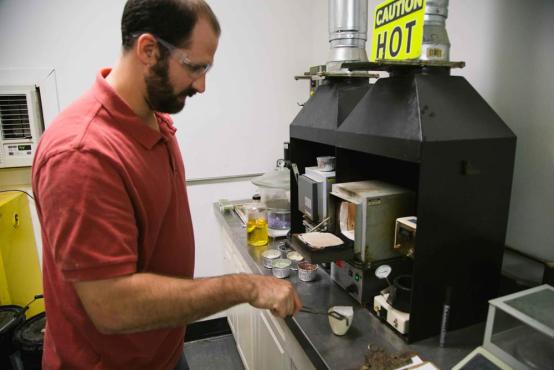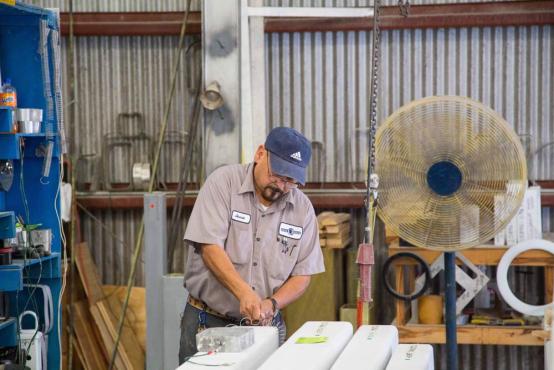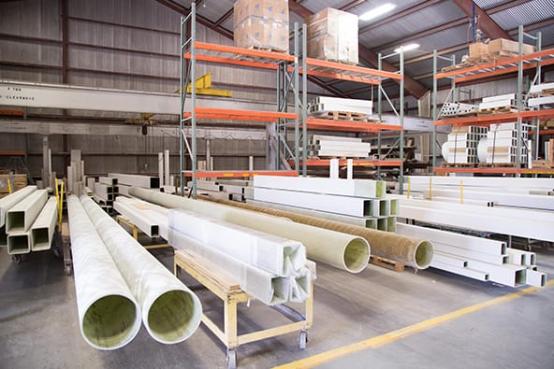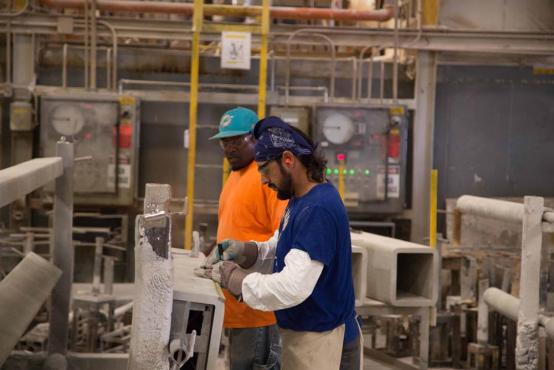Assuring Quality of our Product
There is a wide range of sophistication of products within the world of industrial composites. The function of an insulating ariel boom is subject to the necessary safety performance to protect those working with and around the machines. Waco Boom’s experience informs the design, raw material input, and verification processes established through destructive and nondestructive testing measures.
Waco Boom’s Quality Assurance includes a multitude of measures and defined standards patterned after ISO 9001. Each boom is designated a serial number that traces back to the date of manufacture and all related materials and processes. Quality control and checks are implemented during design qualification, production throughput, and final verification. Raw materials for daily production and research undergo viscosity analysis, fiber counts, and resin mix gel time tests to name a few. Special Testing occurs periodically for the product or experimental material validation.
DIELECTRIC TESTING
DC dielectric testing verifies insulating properties of finished parts. Lower booms are submerged in water for an hour prior to testing. This ensures no wicking or entrapment of moisture that would be detrimental to the insulating performance of the boom. Waco Boom uses a 100KV testing unit and employees attend the Von Corp. course for Electrically Testing Insulated Aerial Lift Devices.
DIFFERENTIAL SCANNING CALORIMETRY (DSC)
Waco Boom Engineering utilizes the DSC for production and research and development for thermal analysis of the curing period, degree of cure, and material properties. The glass transition (Tg) is determined by testing small samples of the boom section.
BURNOUT TEST
Using a muffle-furnace, boom section coupons are set in crucibles. Waco Boom uses this simple, but informative procedure to verify the resin-to-fiber ratio of the FRP laminate. In addition, specific patterns and angles designed in the wind pattern can be qualified.
Maintenance Recommendations
- Not keeping the boom clean inside and out
- A dirty boom does not shed rain as well and can fail periodic dielectric tests
- Cleaning with harsh abrasive cleaners
Abrasives and solvent cleaners are not recommended as they can scratch or soften the surface coatings. There are a number of cleaners recommended for cleaning booms or you can use soap and water. Consult the service department of your manufacturer for their recommendations. - Washing with high-pressure water
This can cause water to diffuse through the fiberglass requiring elevated temperatures or extended time to dry out. Wash by hand and park the boom in a position that allows water to drain. A boom dielectrically tested while it is still wet can cause permanent damage. - Surface cracks due to weather, age or improper paint preparation
These kinds of problems will require refinishing. However, refinishing the exterior of the booms without masking the interior can cause paint overspray to settle on the inside. Our research has shown that this overspray will trap moisture and prevent water from beading on this rough, sandpaper-like surface. This moisture can then lead to failed dielectric tests. - Dielectric testing over 1mA (1000 micro-amps) return current
This process can harm the boom by causing it to burn. If, during your dielectric test, you reach a return current close to 1000 micro-amps, stop the test immediately and examine the boom for a hot spot. Examine the boom for any contamination such as: dirt, moisture, sticks or other debris. Let the boom cool and remove the contamination. (Dirt or moisture can cause the fiberglass to be burnt beyond repair.) - Overloading
Even if the boom does not break, overloading can cause stress cracks and shorten the life of the fiberglass boom. A single overload can shorten a booms service life by months or years. A boom used at the rated load should remain in service for many years. - Not strapping down the boom during travel
Subjecting a boom to repeated jolts can shorten the life of the fiberglass. This shock loading will fatigue the fiberglass and can create impact damage in the area of the boom rest. - Cable cuts and saw cuts
Cuts can weaken the boom in the specific area of the damage. Consult the manufacturer before repairing this type of damage. - Sunshine and ultraviolet radiation
Sunlight and UV can attack an unpainted area of a fiberglass boom causing the exposed area to look fuzzy as the fibers are exposed. Repair surface scratches, to seal out the sun and moisture, to prevent this problem. Watson has a written procedure and instructions on refinishing an insulated fiberglass boom which can be requested by email at watson@watsoncoatings.com - Improper repairs
Using substandard material and improper repair procedures can cause problems. There are two types of repairs. The first is periodic surface repair that involves the outside coating. Second is the structural repair that involves the boom itself. Structural repair should be referred to the manufacturer for a case-by-case study. Examples of structural damage include: cracks, cuts, delamination and impact damage from tree limbs or tools. - Improper Storage
Storing fiberglass booms in direct sunlight, untarped or covered, and directly on the ground are both methods of improper storage which could cause blistering and dielectric failure. Improper storage could also void the warranty. Storage of booms should always be off the ground for air ventilation and away from direct sunlight.
Our Process, Our Booms
Have a question? our experts can help you!




Contact Us
If you have any questions or would like more information on any of our products, please contact us or submit a request.
(254) 776-2556
Mailing Address
PO BOX 20008
Waco, Texas 76702
Shipping Address
481 Texas Central Parkway
Waco, Texas 76712




